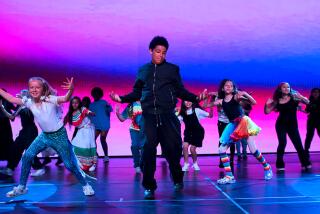Giving History a Musical Spin
- Share via
The illusion of a Gold Rush-era hoedown was pretty good considering the location: a 21st century Orange County elementary school.
As the kids flew through intricate square dances, their sneakers squeaked on the cafeteria’s vinyl floor. The 130 youngsters onstage belting out “Clementine” were just as lively as their mid-1800s predecessors, although those folks never wore T-shirts from Old Navy.
Through an Orange County Philharmonic residency program with Heritage Elementary in Santa Ana, fourth-graders have spent the last five weeks learning the folk dances, songs and instruments that entertained early California settlers.
“It’s a fun exercise for them in history,” said Laurie Gilmore, one of four teachers whose students participated. “These facts go into their minds a lot easier when they’re reliving the settlers’ lives rather than just reading about it in a book.”
The program culminated Thursday with a performance for the school’s second- and third-graders.
The younger children bobbed their heads and tapped their toes while the fourth-graders do-si-doed. And as is common at age 10, most of the girls towered over the boys; all looked like they’d rather eat broccoli than hold hands.
“It was kind of weird dancing with girls at first,” said Luis Cuevas, 10. “But I really liked the promenades.”
This is the Philharmonic residency program’s second year, and officials hope to expand it to three elementary schools next year.
As budget cuts strain the Philharmonic and local school districts, such residencies expose kids to music more economically than concerts that require busing and performance hall rentals.
The arts also engage young minds and improve kids’ memories and reasoning skills, said program coordinator Marilynn Manderscheid. The chance to sing and dance also heightens their enthusiasm for learning, she said.
“Music does their brains good, and it does their hearts good as well,” she said. “Their brains click when they get a chance to create, and they learn how smart they really are.”
From the first day of the residency, when banjo player Gary Francisco pulled up in a small covered wagon, through the rehearsal and performance this week, the kids have been enthralled, their teachers said.
They learned how to square dance and play instruments of the period, including washboards and spoons. They also wrote their own lyrics to 19th century songs.
One example, set to the familiar “Oh! Susanna”: “Oh, California, that’s the land for me / I’m bound for San Francisco with my washbowl on my knee.”
The children wrote the lyrics after their teachers and the artists guided them through research on the era, including a study of how people traveled to Northern California, what was needed in a covered wagon and how mosquitoes carried malaria.
After the dancing, 10-year-old Noel Soria said his favorite thing was learning to play the gutbucket, a homemade bass instrument. To him, adding music made the history that fourth-graders must learn anyway much more interesting.
“I can remember all the things they went through and what happened during the Gold Rush,” he said. “I don’t know how I would have learned all the words so quickly if I wasn’t singing them.”
More to Read
The biggest entertainment stories
Get our big stories about Hollywood, film, television, music, arts, culture and more right in your inbox as soon as they publish.
You may occasionally receive promotional content from the Los Angeles Times.










